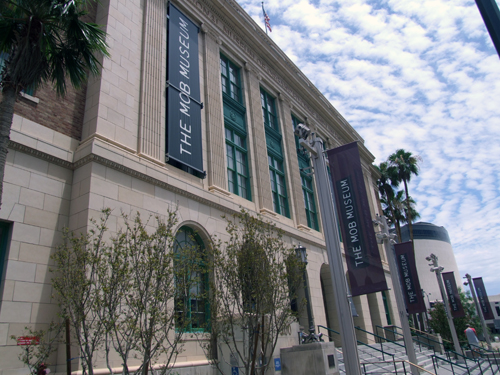
-Ninth in a Series–
By Donald H. Harrison
LAS VEGAS, Nevada – In a former courthouse where U.S. Senator Estes Kefauver (D-Tennessee) once held a hearing to expose the extent to which Organized Crime had corrupted America, Las Vegas today presents “The Mob Museum,” an interactive set of exhibits tracing the rise and fall of some of the country’s most notorious mobsters. These criminals came from many backgrounds, but Italian and Jewish gangsters were particularly prominent – the Cosa Nostra (“Our Thing” in Italian) and the “Kosher” Nostra.
Perhaps on the strength of the hearings that were held in 14 cities, Kefauver became the vice presidential candidate on the Democratic party ticket in 1956 with Illinois Gov. Adlai Stevenson. They lost to incumbent President Dwight D. Eisenhower and Vice President Richard Nixon.
The Volstead Act, which in 1919 imposed prohibition on the United States, gave Jewish, Italian, Irish and other gangs an opportunity to supply the booze at their “speak-easies” to a thirsty nation. There were gangs in almost every metropolitan area that expanded from illegal booze to gambling, prostitution and loan sharking. Aided by Jewish crime figure Meyer Lansky, Italian crime boss Charles “Lucky” Luciano “organized the most powerful underworld organizations into a confederation called the Commission,” according to the museum’s narrative. “Like a board of directors, it recognized different families’ spheres of influence in cities nationwide and they were willing to enforce the peace.”
Although Prohibition lasted only 14 years, by the time it was repealed in 1933, organized crime’s influence was felt in nearly every city. Mobsters constituted a national syndicate, controlling far more resources and firepower than many local governments could muster to fight them. Lansky boasted: “We’re bigger than U.S. Steel.”
Though Lansky would die an octogenarian at home, other Jewish mobsters were not so lucky.
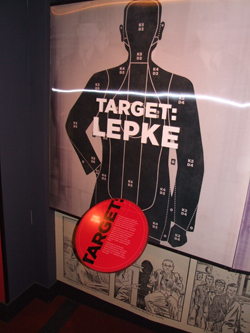
Louis “Lepke” Buchalter was a Lansky lieutenant, who served as a mob enforcer. As one of the chiefs of “Murder Incorporated,”Buchalter arranged the deaths of those the mob thought were too great an inconvenience to keep around. Among the murder victims was Joseph Rosen, who had once been a Buchalter associate. While serving time at Leavenworth federal prison for narcotics offenses, Buchalter was convicted in New York State along with his associates Louis Capone and Mendy Weiss for the Rosen murder.
Eventually, Buchalter was extradited to New York State where his prosecutor, District Attorney Thomas Dewey of New York City, since had been elected governor. Dewey turned down Buchalter’s appeal for clemency. When he was executed on March 4, 1944, Buchalter was considered the richest man ever to die in Sing Sing’s electric chair. Dewey went on to become the unsuccessful Republican presidential candidate in 1944 and again in 1948, losing successively to incumbent Presidents Franklin Dr. Roosevelt and Harry S. Truman.
A model of the electric chair is one of the exhibits at the Mob Museum. Visitors may sit in it and get a slight buzzing sensation, as I found out when my grandson Shor threw the switch. Another exhibit is a photo of Louis Capone and Mendy Weiss after being sentenced to death in the Rosen murder. The caption on the photo is “why are they smiling?” Bravado, pure and simple.
Benjamin “Bugsy” Siegel, who helped the Luciano-Lansky mob to develop gambling in Las Vegas, Nevada, was murdered in 1947 while staying at a home he shared with Virginia Hill in Beverly Hills, California. It’s never been learned who did it, but one generally accepted theory was that the Syndicate was tired of Siegel’s flamboyance and the cost overruns at the Flamingo Hotel on the Las Vegas Strip, located some seven miles from downtown Las Vegas and then outside its police force’s jurisdiction. Rumors that he and Hill were skimming money sealed his doom, according to the accepted theory.
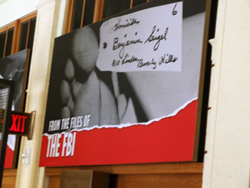
At the Mob Museum, one can see a blow-up photo of a tag with Siegel’s name on it hanging from a toe of his corpse.
In the Las Vegas courtroom where Kefauver held the hearings, a video recounts some of the more dramatic moments. When one senator suggested sarcastically to mobster Moe Dalitz that he had developed quite a nest egg from rum running, Dalitz smiled tauntingly, and said, “Well, I didn’t inherit any money, senator!”
Mickey Cohen was another of the mobsters investigated by the Kefauver Committee, and was eventually convicted for tax evasion. After serving his time, Cohen became involved in various activities, some legitimate. One of the exhibits at the Mob Museum is a fancy set of pajamas, such as those sold by Cohen’s haberdashery store.
Besides telling the stories of the mobsters, the museum tells of the efforts of such law enforcement officials as J. Edgar Hoover of the FBI, District Attorney Dewey, and Senator Kefauver to defeat the mob through the combination of arrest, prosecution and legislation. Visitors are invited to pretend they are FBI agents practicing at a target range for a potential shoot-out with mobsters.
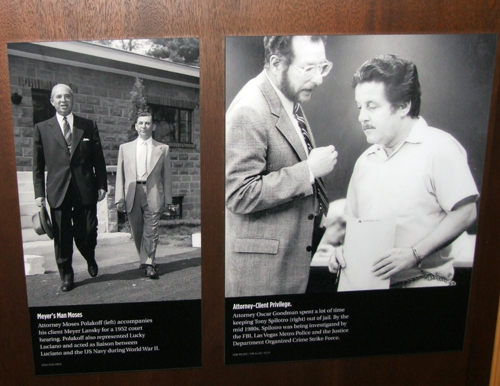
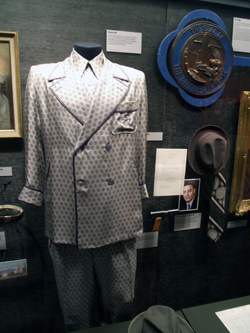
Another exhibit tells of some of the lawyers who represented the mobsters in their many court battles. Moses Polakoff is pictured in a 1952 photo with Meyer Lansky, and Oscar Goodman is shown in the 1980s with his client Tony Spilotro. Of San Diego interest, Goodman once represented San Diego Mayor Roger Hedgecock in the campaign contributions case that drove him from office. Hedgecock went on to become a popular radio host, and Goodman later became a mayor himself – of Las Vegas.
The museum also has an exhibit about the many popular movies that have been made about gangsters and mob members, starring such actors as Edward G. Robinson, Jimmy Cagney and George Raft. The most popular—which helped the public to understand both the attraction and repugnance of the mob – was The Godfather series starring Marlon Brando and Al Pacino.
Not far from the Mob Museum is the Golden Nugget, a huge downtown Las Vegas casino and hotel complex that includes two large aquariums, one of them alongside the large swimming pool. Enjoying our stay over at the hotel, grandson Shor and I found it a bit thrilling—and somewhat ironic, given our exposure to mob parlance—that so many visitors to Las Vegas were anxious to “swim with the fishes.”
*
Harrison is editor of San Diego Jewish World. He may be contacted via donald.harrison@sdjewishworld.com